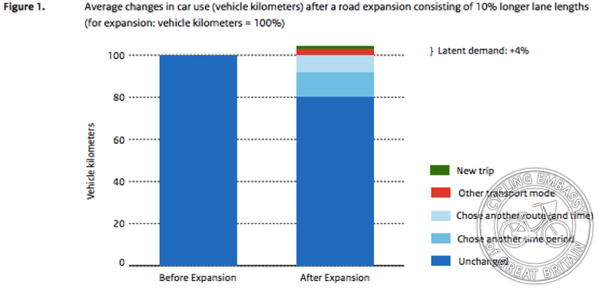Induced demand
“If you build more space for motor traffic, you will get more motor traffic”. Induced demand is the idea that building more roads will generate more demand for those roads.
Analysis and data from at least the last 50 years shows that when we build more roads, we get more traffic. This is partly down to ‘induced demand’ - as it becomes perceptively easier and easier to take a car for a journey, so it becomes more likely that someone will make that choice.
Invariably we build new roads because the current roads are congested. However, data suggests that when these roads have been built, they service not only the existing traffic mix, but support additional journeys which were not previously made by car (or were made at other times, or by other routes), as well as enabling entirely new journeys.

The graph above (source) shows how 'expanded' road capacity is subsequently filled up by drivers who used to choose other routes, or other times of travel (pale blue). Thus the beneficial effect of building the new road is only marginal.
See also this explanation (p.26) from a report for Transport for London -
New trips generate some societal value in the short term, as travellers enjoy the benefits of quicker journey times. However, as traffic levels increase and journey speeds fall, these benefits are lost. What remains are the externalities caused by the new trips in the form of pollution, parking space requirements and incidence of collisions.
This is also known as The Black Hole Theory of road investment -
"Initial investments in improved highway facilities result in greater ease of travel and hence altered travel patterns, including an increase in average trip length and in the number of trips being made. Over time, as shown in Figure 18.1, this increased demand stimulated by the initial investment in increased transport supply fuels the need for even more facilities, and the feedback process repeat itself. This familiar phenomenon has been called the black-hole theory because some people claim that investing in highways is like throwing money into a black hole" (Plane, 1995 p.439)
Figure 18.1 -

More recently, a widening scheme on the M25 - involving all-lane running - saw a large 10-13% increase in motor traffic, in just the first year of operation, oustripping the 3.5% growth in motorway traffic across Britain in the equivalent period. The extra capacity created was quickly filled up.
Of course, the logic of 'induced demand' also works for cycling infrastructure. In places where improved cycling facilities are created, people tend to cycle more - a virtuous circle.
